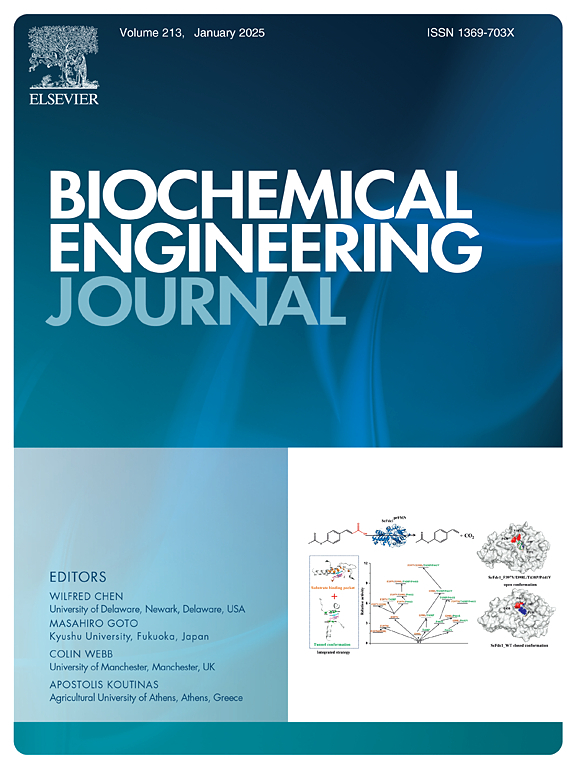Improvement of sludge dewatering performance by persulfate advanced oxidation combined with LDH: Synergistic effect of free radical and non-free radical and reuse of deep-dewatered sludge cake
IF 3.7
3区 生物学
Q2 BIOTECHNOLOGY & APPLIED MICROBIOLOGY
引用次数: 0
Abstract
The high-water content of sludge in wastewater plant will influence the transportation and utilization. In this study, a new method for improving sludge dewatering by pyrite (FeS2) activated persulfate (PMS) combined with layered double hydroxide (LDH) was proposed. After conditioning, the water content (Wc) and specific resistance (SRF) of sludge decreased from 97.12 % and 1.83 × 1013 m/kg to 71.39 % and 1.84 × 1012 m/kg, severally. SEM and particle size analysis showed the system could destroy sludge cells effectively.The mechanism analysis of protein and polysaccharide content, 3D-EEM, FTIR, XPS results showed that FeS2/PMS-LDH combined system was beneficial to break down the sludge extracellular polymer (EPS), transform and accumulate the organic matter into the EPS outer layer, release the bound water. Both free radical and non-free radical play a role in oxidation, and they cooperate to break EPS. The effective phosphate adsorption performance of the biochar adsorbent prepared from dehydrated sludge cake was also investigated. The adsorption behavior of phosphate on biochar from dewatered sludge cake belongs to uniform chemical monolayer adsorption. When T = 298k, PH = 5, the maximum adsorption capacity is 20.255 mg/g. The introduction of LDH is helpful to enhance the sludge dewatering and the adsorption of phosphate. To sum up, the combined conditioning method considers the effectiveness of sludge dewatering and the feasibility of sludge cake disposal and utilization.
过硫酸盐高级氧化结合 LDH 改善污泥脱水性能:自由基和非自由基的协同效应以及深度脱水污泥饼的再利用
污水厂污泥含水率高,会影响污泥的运输和利用。本研究提出了一种利用黄铁矿(FeS2)活化过硫酸盐(PMS)结合层状双氢氧化物(LDH)改善污泥脱水的新方法。经过调理后,污泥的含水率(Wc)和比阻力(SRF)分别从 97.12 % 和 1.83 × 1013 m/kg 降至 71.39 % 和 1.84 × 1012 m/kg。蛋白质和多糖含量的机理分析、3D-EEM、傅立叶变换红外光谱、XPS 结果表明,FeS2/PMS-LDH 组合系统有利于分解污泥胞外聚合物(EPS),将有机物转化并积聚到 EPS 外层,释放结合水。自由基和非自由基都在氧化过程中发挥作用,它们共同作用使 EPS 断裂。研究还考察了脱水污泥饼制备的生物炭吸附剂对磷酸盐的有效吸附性能。脱水污泥饼生物炭对磷酸盐的吸附行为属于均匀化学单层吸附。当 T = 298k,PH = 5 时,最大吸附容量为 20.255 mg/g。LDH的引入有助于提高污泥脱水和磷酸盐的吸附能力。总之,联合调理法既考虑了污泥脱水的有效性,又考虑了污泥饼处置和利用的可行性。
本文章由计算机程序翻译,如有差异,请以英文原文为准。
求助全文
约1分钟内获得全文
求助全文
来源期刊

Biochemical Engineering Journal
工程技术-工程:化工
CiteScore
7.10
自引率
5.10%
发文量
380
审稿时长
34 days
期刊介绍:
The Biochemical Engineering Journal aims to promote progress in the crucial chemical engineering aspects of the development of biological processes associated with everything from raw materials preparation to product recovery relevant to industries as diverse as medical/healthcare, industrial biotechnology, and environmental biotechnology.
The Journal welcomes full length original research papers, short communications, and review papers* in the following research fields:
Biocatalysis (enzyme or microbial) and biotransformations, including immobilized biocatalyst preparation and kinetics
Biosensors and Biodevices including biofabrication and novel fuel cell development
Bioseparations including scale-up and protein refolding/renaturation
Environmental Bioengineering including bioconversion, bioremediation, and microbial fuel cells
Bioreactor Systems including characterization, optimization and scale-up
Bioresources and Biorefinery Engineering including biomass conversion, biofuels, bioenergy, and optimization
Industrial Biotechnology including specialty chemicals, platform chemicals and neutraceuticals
Biomaterials and Tissue Engineering including bioartificial organs, cell encapsulation, and controlled release
Cell Culture Engineering (plant, animal or insect cells) including viral vectors, monoclonal antibodies, recombinant proteins, vaccines, and secondary metabolites
Cell Therapies and Stem Cells including pluripotent, mesenchymal and hematopoietic stem cells; immunotherapies; tissue-specific differentiation; and cryopreservation
Metabolic Engineering, Systems and Synthetic Biology including OMICS, bioinformatics, in silico biology, and metabolic flux analysis
Protein Engineering including enzyme engineering and directed evolution.
 求助内容:
求助内容: 应助结果提醒方式:
应助结果提醒方式:


